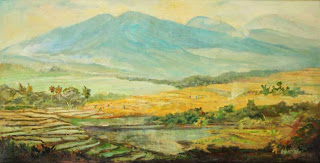ARTIST DETAILS
W.G. Hofker (1902 - 1981)
Willem Gerard Hofker was born on 2nd May 1902 in The Hague, the Netherlands, as a son of Gerrit Jan Hofker, public servant with the Postal Services.
For a while his father was a co-worker of De Nieuwe Gids and befriended members of the Eighties movement. He named his son after the painter Willem Witsen.
Willem Hofker firstly attended the Haagse Academie and later, at age 14, attended the Rijksacademie voor Beeldende Kunsten in Amsterdam. He was also educated by Willem Witsen and Isaac Israel who were friends of his father, an amateur artist and writer, member of the literary movement 'de beweging van Tachtig'. In 1927 Willem Hofker won the 2nd price at the Prix de Rome. In 1930 he married Maria Rueter, also a painter, daughter of Georg Rueter, painter and lector at the Rijksacademie voor Beeldende Kunsten in Amsterdam.
In the twenties Hofker concluded a number of monumental-decorative assignments, amongst others for the Koninklijke Nederlandsche Stoomvaart Maatschappij (KNSM), for whom he made a few mural paintings on ships. Little is left of these assignments. Hofkers reputation as a portrait painter was such, that he received the assignment in 1936 to paint a portrait of queen Wilhelmina for the head office of the Koninklijke Pakketvaart Maatschappij (KPM) in Batavia, the former Dutch colonies in East-Indies.
In 1938 the couple accompanied the painting to the Dutch East-Indies and concluded with a trip through the colonies. During this trip they made drawings and paintings of Indonesian subjects which could be reproduced and used by the KPM.
The Hofker couple settled in Bali where Willem made popular drawings of Balinese landscapes and dancers. The Hofkers socialized with many painters, amongst other Spies, Strasser, Meyer and their good friend Rudolf Bonnet. In 1940 the couple moved to Ubud. In the period between 1938 to 1944 most of Hofker's work in Indonesia was made. His art pieces were refined and flowing, as well as poetic. In Bali he mainly painted temples and religious life on the island and he concentrated on the people of Bali. Many of his paintings are exhibited in Ubud in ARMA and the Neka Museum.
In the Second World War Hofker and his friend Bonnet were forced by the KNIL (Royal Dutch East-Indies Army) in Surabaya to join the services, upon which his wife and he were interned, by the Japanese occupier, in different camps in 1943, he himself in Tana Toraja, in central Celebes (Sulawesi). During this period most of the sketches of Maria Hofker were lost. At the end of the war the couple did not want to join the Indonesian nationalists and returned to the Netherlands.
Back in the Netherlands, in 1946, a difficult period arose for the Hofkers. The artistic climate had meanwhile changed entirely. The figurative work of Willem hardly found any recognition among colleagues. Fortunately portrait assignments started coming in quickly. In all Willem Hofker has painted approximately 800 portraits for individuals and for organizations, amongst which universities and banks. Including, in 1970, the portrait of Herman van den Wall Bake, president-director of the Algemene Bank Nederland (ABN). Willem Hofker also specialized in crayon drawings of city scapes of Amsterdam, where he mainly focused on architecture, 'portraits' of houses and cities. These Amsterdam drawings were bundled in three books. The Balinese collection appeared under the title 'Bali as seen by Willem Hofker' (1978). In the Netherlands Willem Hofker still recorded people and landscapes of Bali on paper and canvas.
During the latter part of his life Willem Hofker has lectured much and also through the publishing of his drawings his reputation increased again. At this moment his Balinese landscapes and dancers are very much in demand. And also internationally the creations from Hofkers Balinese period in the last few years draw much attention.
Willem Hofker lived in the Zomerdijkstraat in Amsterdam from 1934 to 1938 and from 1946 to 1967. He died in Amsterdam on 30th April 1981.
Another reference:
http://www.facebook.com/home.php#!/event.php?eid=294197969771
ARTWORK DETAILS:
ARTWORK DETAILS:
Painter : W.G. Hofker
Subject/ Title : 4 span voor bierwagen
Dimension : 35 X 63 cm
Media : etch on paper
Signature & remarks : dated 1947, signed lower left: “W.G. Hofker” with pencil signature.
History/ provenance
of painting : authentic with no COA or provenance provided, only limited warranty letter from the present owner/ gallery*. The present owner acquired the painting from private collection of the previous owner.
Condition : The overall is good & well preserved; no trails of restoration or revision are found.
SOLD
ARTWORK DETAILS:
Painter : W.G. Hofker
Subject/ Title : Cathedral - 1949
Dimension : 49.5 X 27.5 cm
Media : etch on paper
Signature & remarks : dated 1949, signed lower left: “W.G. Hofker” with pencil signature.
History/ provenance
of painting : authentic with no COA or provenance provided, only limited warranty letter from the present owner/ gallery*. The present owner acquired the painting from prominent auction house.
Condition : The overall is good & well preserved; no trails of restoration or revision are found.













